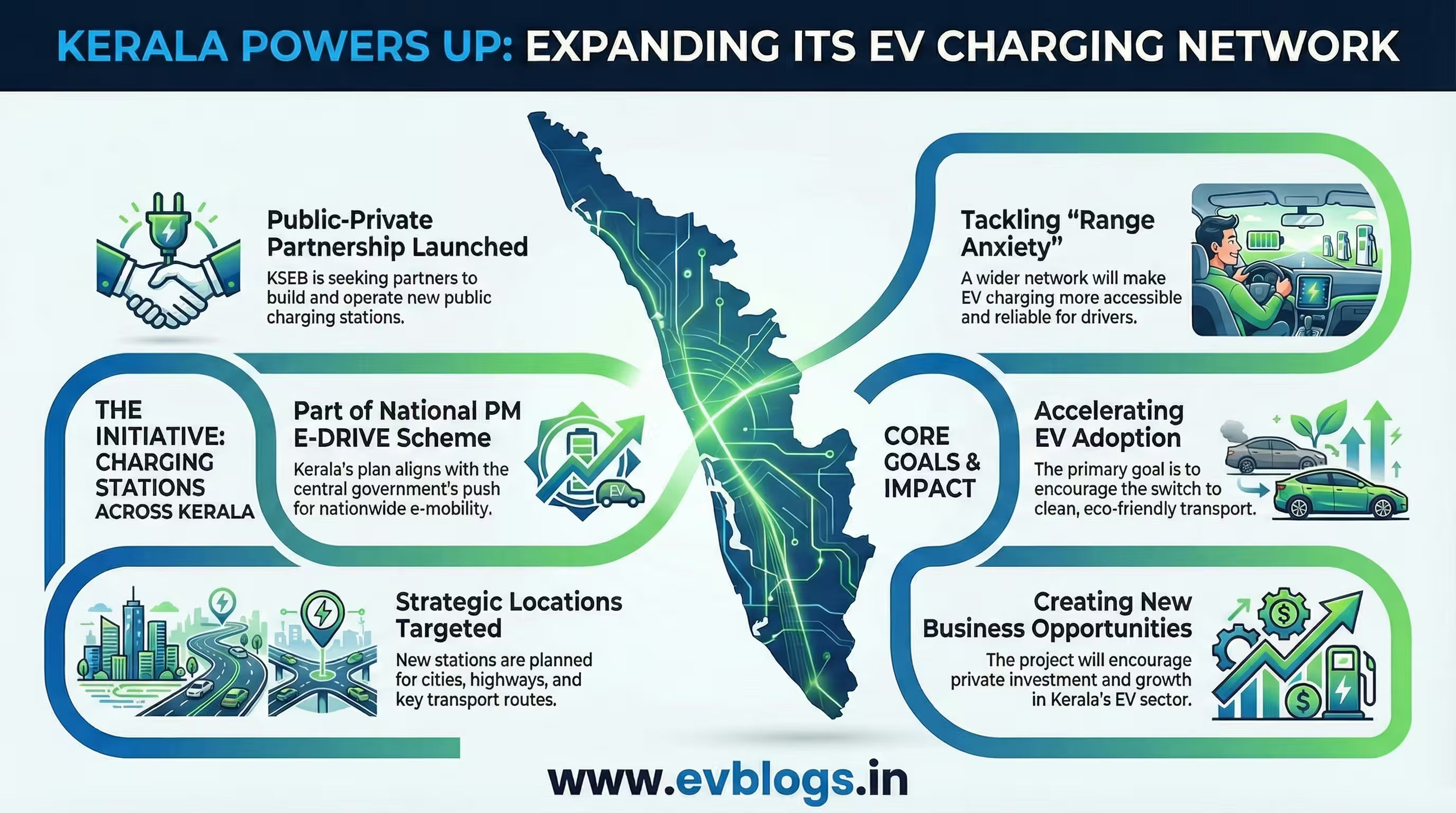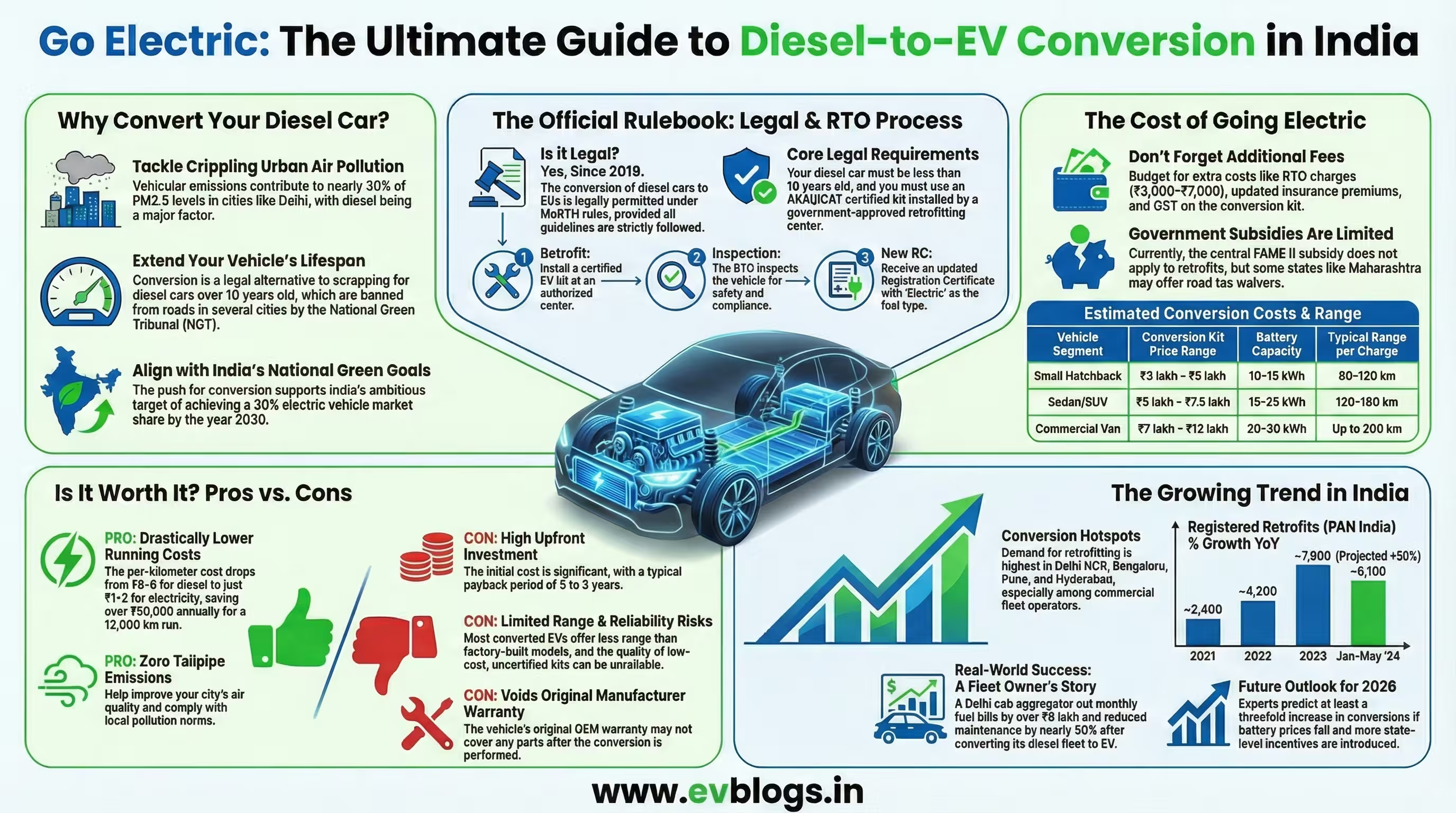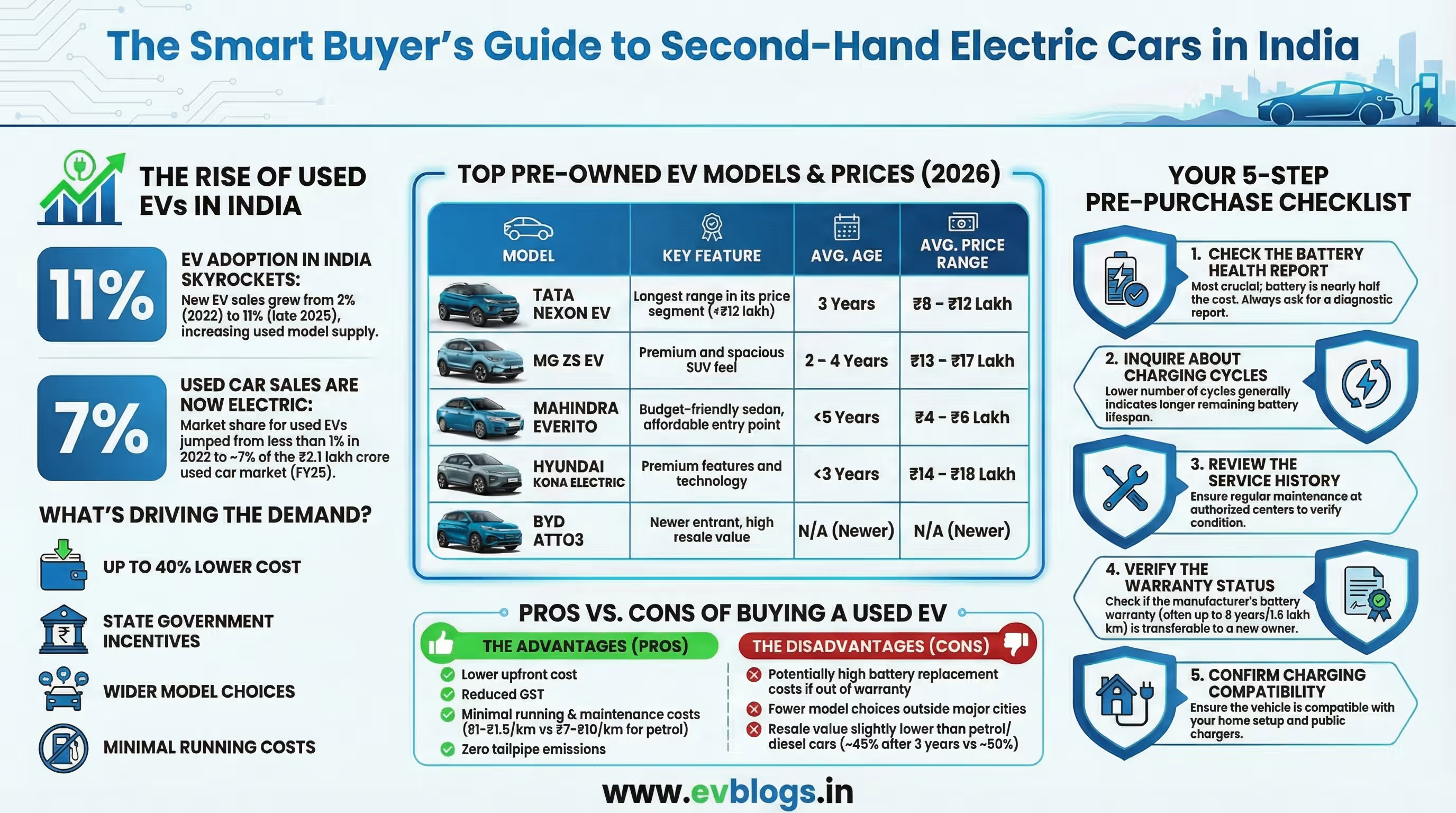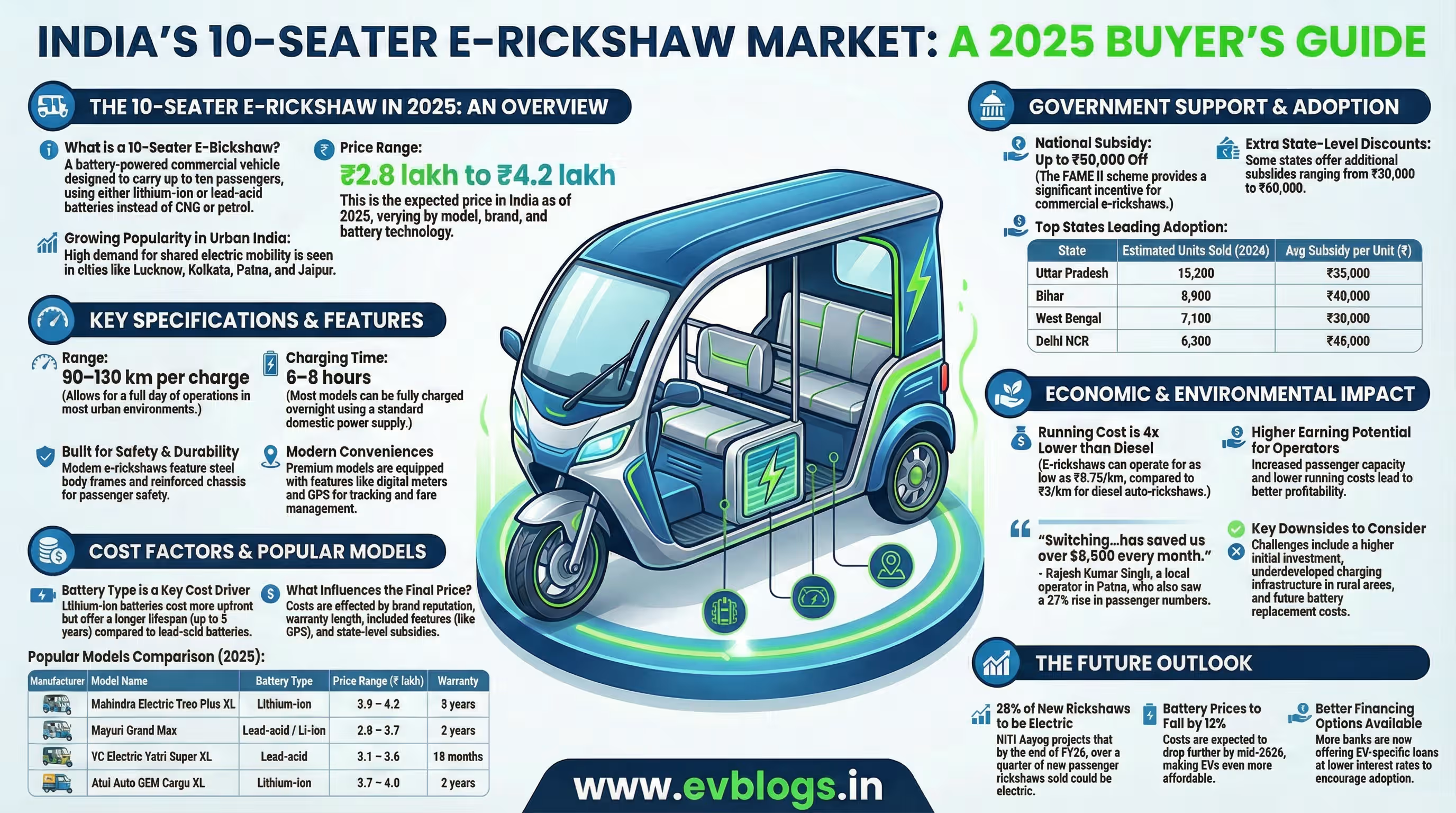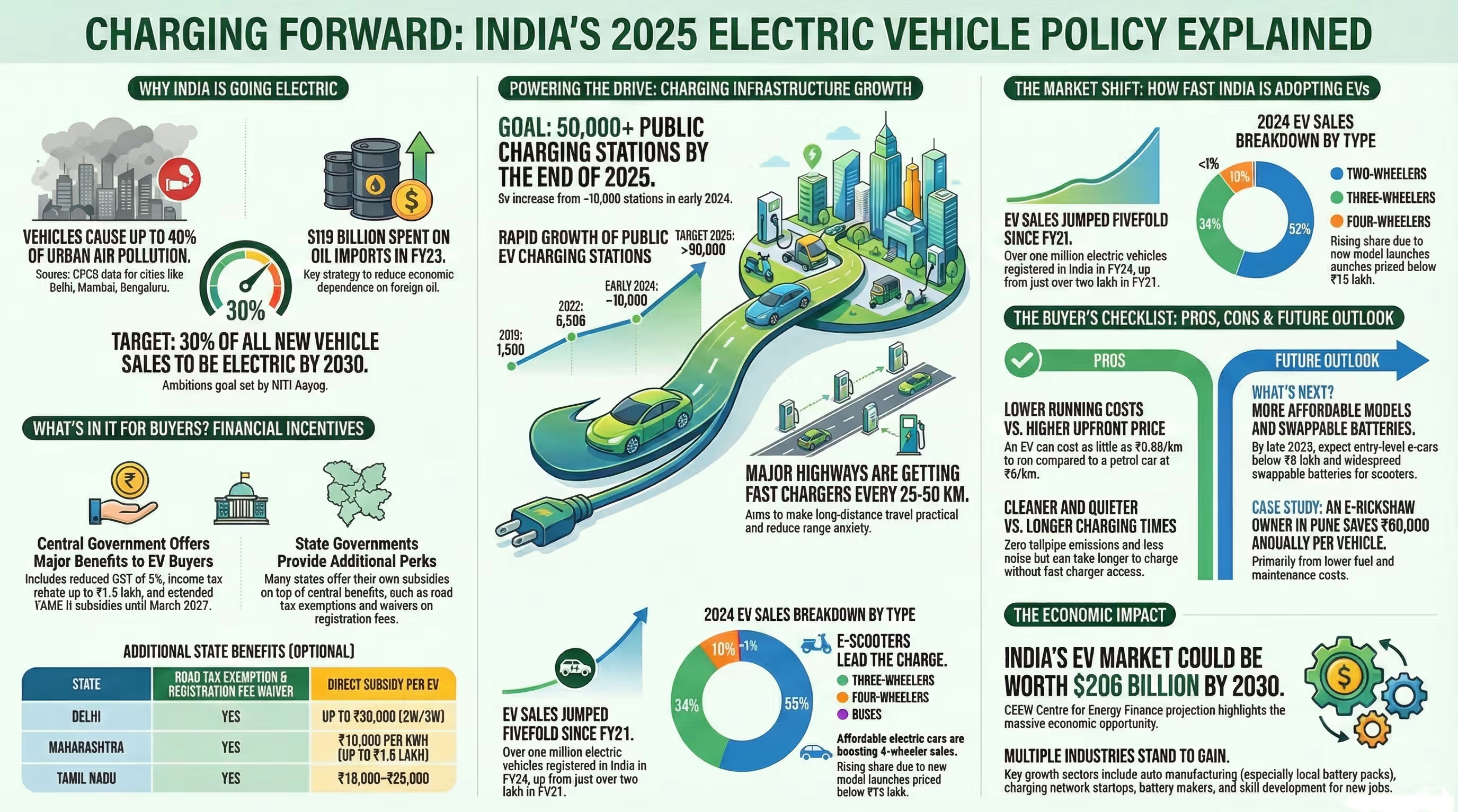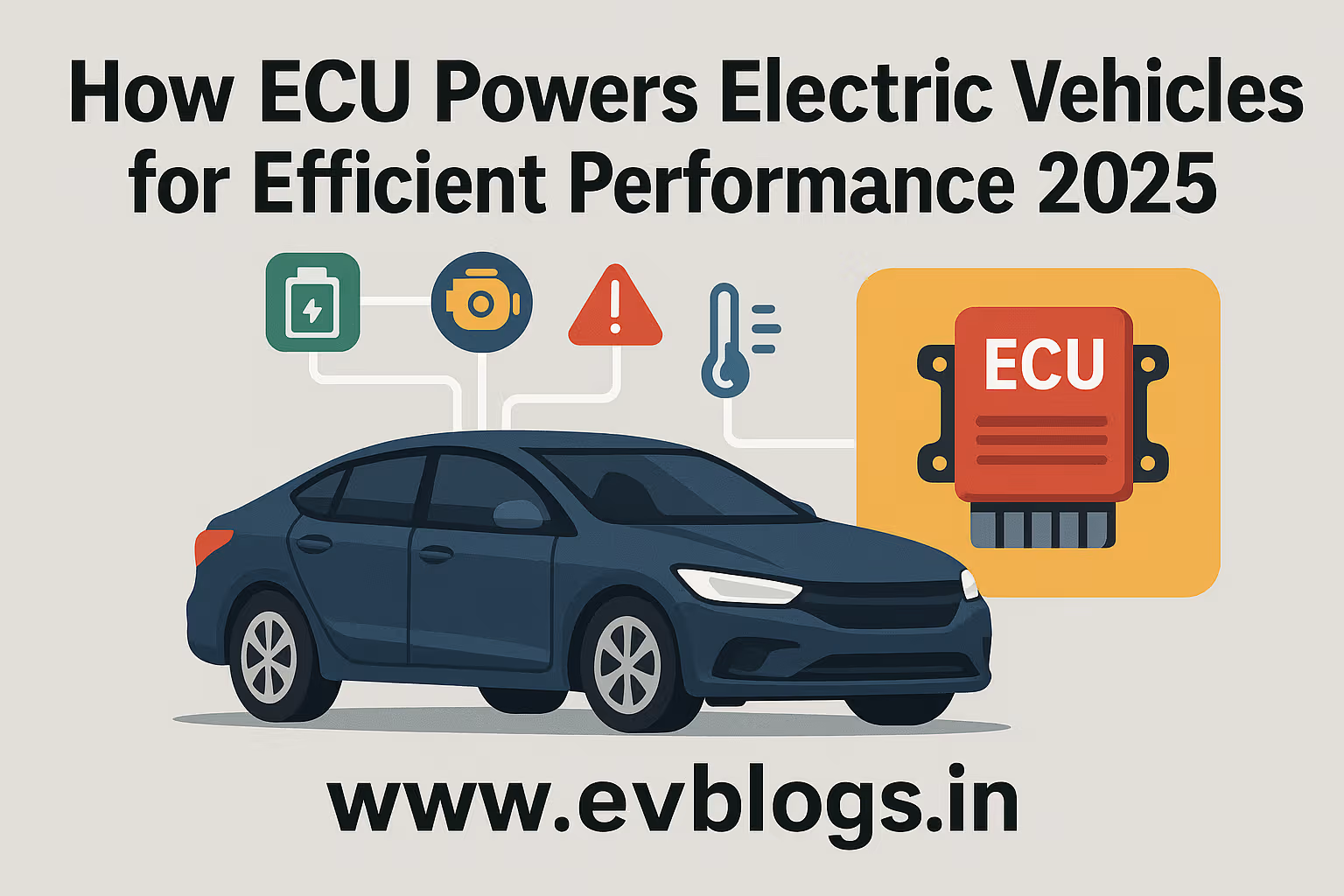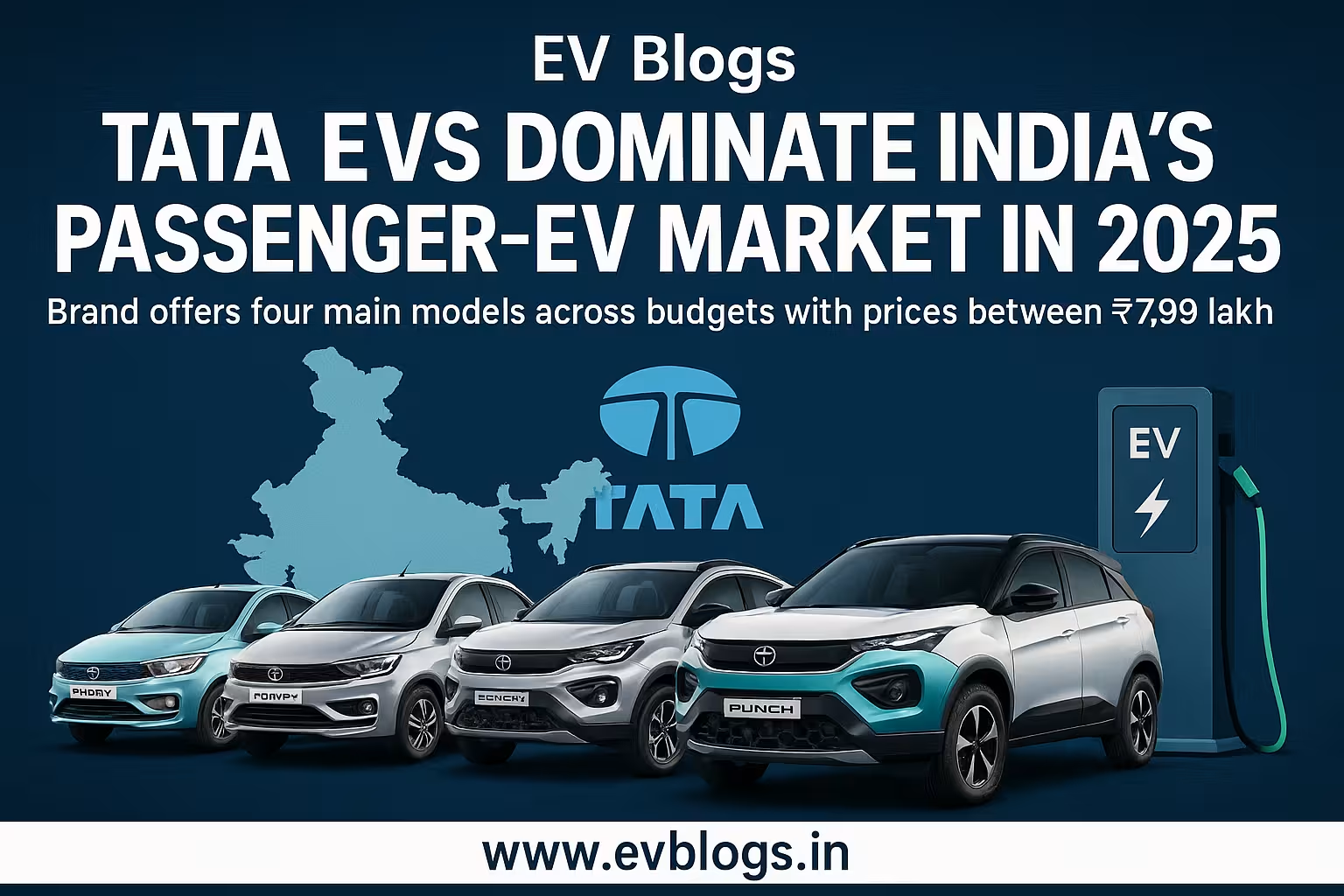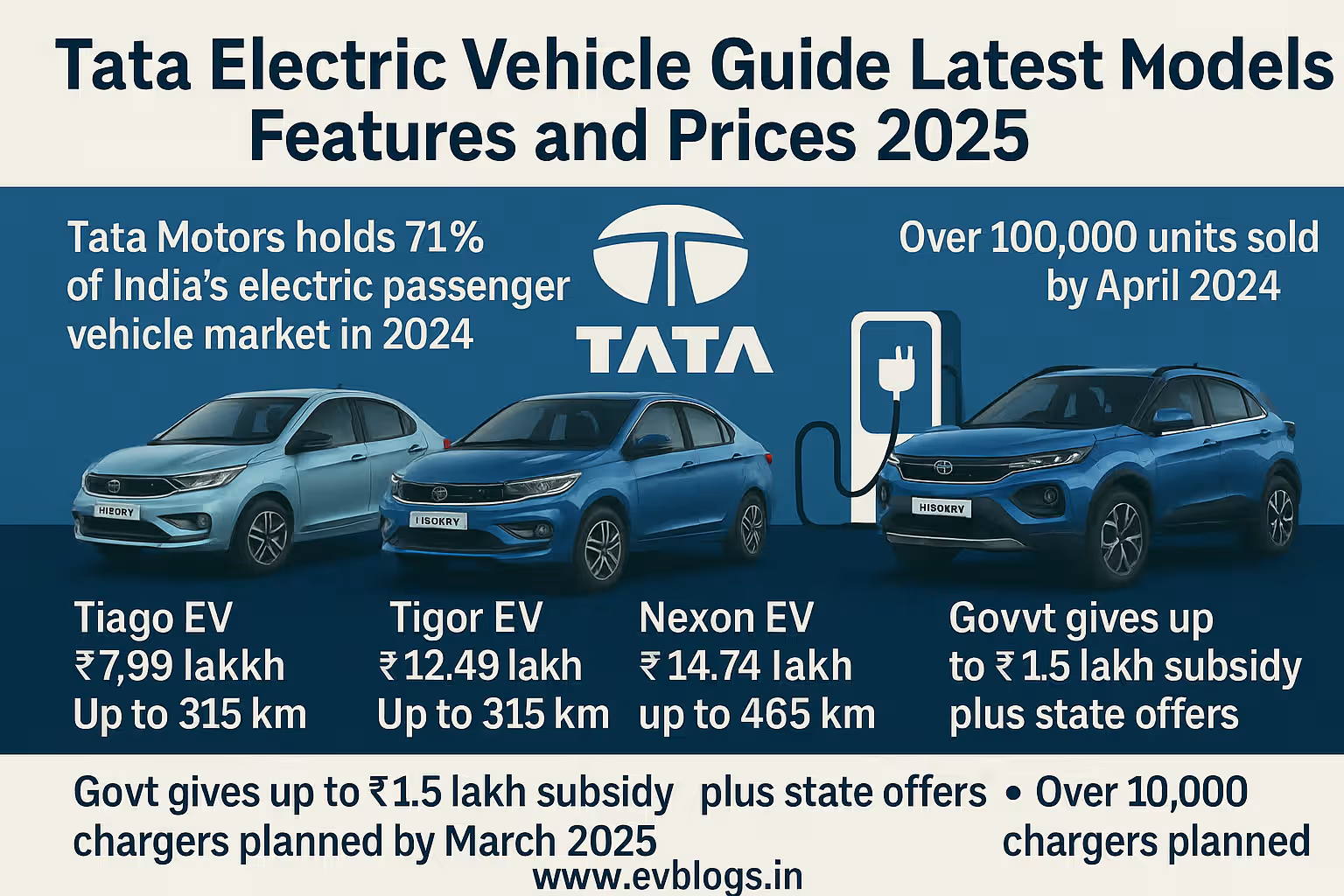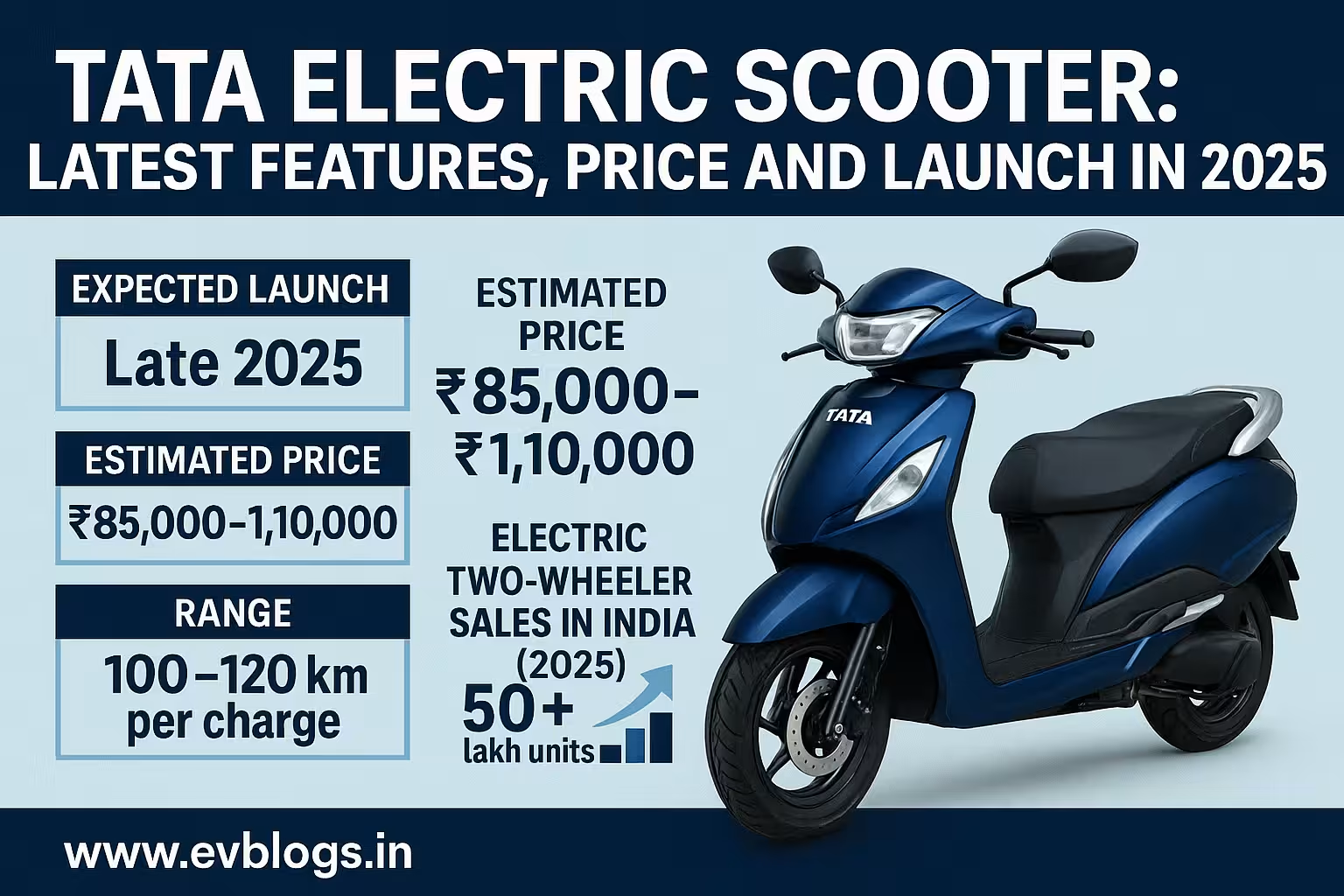Hedhvick Hirav
Hedhvick Hirav is a dedicated EV researcher and editor with over 4 years of experience in India’s growing electric vehicle ecosystem. Their contributions have been recognized in leading sustainability publications and automotive journals.
Summarize & analyze this article with
Choose an AI assistant and open this article directly:
Tip: if the AI doesn’t fetch the page automatically, paste the article URL manually.
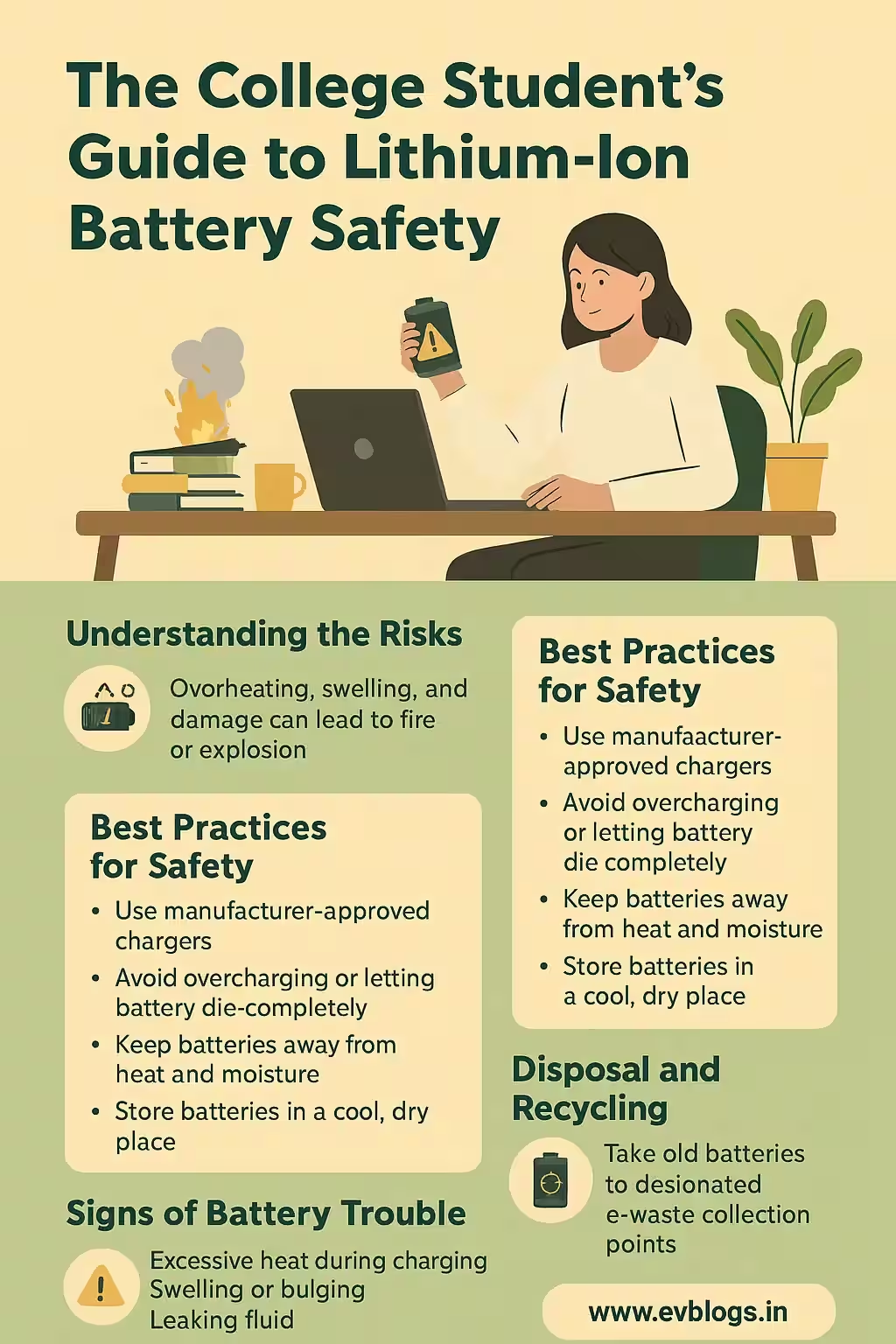
What are the Lithium-Ion Batteries in electric vehicles and why should Indian College Students Care in 2025?
Li-ion batteries are the hearts of electric vehicles (EVs) in India as of date. Regardless of whether you are thinking of purchasing your first electric vehicle or you are looking at using one as a college student, you need to understand these batteries. By 2025, e-scooters and e-bikes are cutting through Indian campuses, so the safety of batteries becomes a top concern.
- Li-ion batteries hold and give off energy through an electro-chemical action with lithium.
- They are lighter and faster to charge and have a longer life than the older batteries (such as lead-acid).
- The Indian government released its FAME II scheme and state subsidies that have made EVs more accessible to students.
- The biggest Indian EV makers, Ola, Ather, TVS, and Bajaj apply Li-ion technology in their electric scooters and e-bikes.
- Charging points There are provisions of charging points in most of the City colleges targeting the student riders in India.
- You should care because how you use and take care of these batteries not only influences your ride but also your safety, wallet and even the environment.
Your Check List of Safety The EV market in India will grow at more than 40 per cent CAGR between 2024 and 2030 especially because college students and young professionals are in the process of abandoning two-wheelers.
How Safe will Lithium-ion batteries in Indian electric vehicles be in 2025?
Battery safety is an issue of primary concern to all the people, especially college students who charge, park, and ride EVs on a daily basis. Poor charging, low-quality batteries, or high temperatures may make even a regular commute a safety problem.
- Indian leading electric car producers follow the battery safety standard of AIS-156 (updated in 2023).
- In India (2022-2024) majority of battery fires occurred because of cheap, uncertified batteries or unapproved chargers.
- Newer EVs being sold after April 2024 will have new Battery Management Systems (BMS) that avoids overheating, overcharging and short circuiting.
- The Indian government also requires all EV batteries to be certified by BIS (Bureau of Indian Standards) in 2025.
How will thou receive this?
- Only BIS certified EVs and batteries should be used.
- Never use other than manufacturer-recommended chargers.
- It is not advisable to leave your EV under the sun in peak Indian summer, especially when it is directly exposed to sunlight and not in a shaded area.
Expert Insight A 2025 report by the Indian Institute of Science (IISc), concluded that proper use and certified batteries reduced the risk of EV fires to over 90 percent among college users.
What are the safest Lithium-ion batteries available in Indian Electric Vehicle brands in 2025?
India has over a dozen EV brands, which can make it difficult to choose one even when it comes to battery safety. This comparison will help you choose between them in 2025 in detail.
| Brand | BIS Certified | AIS-156 Compliant | Battery Warranty | BMS Technology | Fast Charging | Cell Origin | User Safety Features | Typical Range (km) | Price (Rs, 2025) |
|---|---|---|---|---|---|---|---|---|---|
| Ola Electric | Yes | Yes | 3 years/40,000km | Multi-level BMS | Yes | Local + Imported | Thermal cut-off, alerts | 140-180 | 1,19,000-1,49,000 |
| Ather Energy | Yes | Yes | 3 years/30,000km | Advanced BMS | Yes | India | App alerts, cell balancing | 110-150 | 1,22,000-1,45,000 |
| TVS iQube | Yes | Yes | 3 years/50,000km | Smart BMS | Yes | India | Battery safety lock | 100-145 | 1,16,000-1,40,000 |
| Bajaj Chetak | Yes | Yes | 3 years/ 50,000km | Smart BMS | Yes | India | Thermal, short-circuit prot. | 90-130 | 1,15,000-1,40,000 |
| Hero Vida | Yes | Yes | 3 years/30,000km | Advanced BMS | Yes | India | Battery analytics in app | 110-140 | 1,19,000-1,48,000 |
| Simple Energy | Yes | Yes | 3 years/40,000km | 4-level BMS | Yes | India | Smart alerts, modular pack | 150-210 | 1,30,000-1,65,000 |
| Pure EV | Yes | Yes | 3 years/40,000km | Custom BMS | Yes | India (Hyderabad) | Temp monitoring, lock | 80-140 | 1,09,000-1,35,000 |
| Bounce Infinity | Yes | Yes | 3 years/30,000km | Swappable BMS | Yes | India | Swap station safety checks | 85-110 | 89,000-1,22,000 |
| Okinawa | Yes | Yes | 2 years/25,000km | Standard BMS | Yes | Imported | Basic alerts | 90-120 | 85,000-1,05,000 |
| Ampere | Yes | Yes | 3 years/30,000km | Smart BMS | Yes | India | Regenerative braking safety | 80-120 | 80,000-1,15,000 |
That is how these features may have an impact on your decision:
- Ola Electric: Leading in thermal safety, real-time alerts and cell quality. Appealing to technologically-aware customers.
- Ather Energy: Daily safety is improved by dependable app integration and cell balancing.
- VS iQube and Bajaj Chetak: They are concentrated on reliable smart BMS and reliable after-sales services.
- Hero Vida & Simple Energy: Provide high-quality analytics and per module battery safety.
- Pure EV Bounce Infinity: Swappable battery technology, Targets the hostel users due to quick charging.
- Okinawa & Ampere: Basic safety, most affordable, and suitable to the student with a limited budget.
Your Check List of Safety No new Indian EVs will be able to use non-BIS and non-AIS-156-certified batteries by 2025. Incorrectly using uncertified batteries may void your warranty and insurance.
What are the Current Safety Problems with Lithium-ion batteries Used by Indian College Students in 2025?
Even after the advances, students get to face adversity in the form of battery safety in real life. Awareness can keep you out of them
- Overheating: This happens when the battery is charged quickly during afternoons especially under outdoor parking.
- Deep Discharge: Prolonged periods of idleness (several weeks) may shorten the life of the battery particularly over the holidays.
- Water Damage: Withstand torrential rains with no battery pleats.
- Unauthorized peripherals: The buying of non-branded cheap chargers in internet market.
- Physical Destruction: Destroying e-scooters using an area in the hostel that is always busy.
Real accounts of 2024-2025:
- A Delhi University student has seen his battery overheat when he charged it with the help of a third-party fast charger purchased online. The BMS powered off the charge, and the battery dropped 20 percent capacity.
- In Pune, there was also a case where four e-bikes were shared by some hostel residents on a single extension cord that caused a small fire because of overloading.
- During the 2024 monsoon, e-scooters were parked in flooded regions that caused battery failures in multiple southern campuses.
Avoid these by
- Charging in dry and shaded, well-ventilated locations only.
- And never daisy-chaining extension cords to charge.
- Always wiping your ride dry after a rainstorm then charging it
Expert Insight The CEA in India reckons that 80 percent of electric vehicle battery-related incidents in 2024 were due to inefficient charging habits and using modified accessories, primarily among college-going consumers.
What is the Lifespan of an Electric Vehicle Battery and When to Replace or service it in India?
Being able to know when to either service or replace your EV battery is vital to safety and savings.
Signs that It Is Time:
- Marked decline in range (e.g. your 100km scooter range at 70km per charge).
- Battery requires an abnormal amount of time to charge.
- A strange odor, swelling, heating during charging.
- Changed battery-related error messages on the dashboard or app of your EV.
Normal Indian EV battery life time
- It only lasts 800 to 1,200 charge cycles (approximately 3 to 5 years of college use).
- In 2025, the majority of brands come with a 3-year warranty; higher-end models can have a warranty as long as 5 years.
Where to service or repair:
- Only go to the authorized service centers–most Indian EV OEMs have a pan-Indian network.
- Never purchase second-hand batteries which are unverified.
- Make use of formal battery recycling and exchange programs.
Your Check List of Safety In 2025 the Battery Waste Management Rules issued by the Indian government will outlaw the disposal of used EV batteries in general trash. You have to use legitimate collection points
How Can the College Students in India Get the Maximum Safety and Life of the Lithium-ion Battery in their EV?
Your daily routines are significant in making your EV battery safe and healthy. Battery life can be extended with a few simple procedures and can give safe commutes through college.
Best Practices:
- Always plug in the charger supplied by your EV make
- Charging to more than 90 percent or discharging below 20 percent should be avoided.
- Park where there is shade or cover, excessive heat diminishes the battery life.
- The software can also be updated; the battery can be improved through software update.
- Clean and dry battery and charging port.
- Removable batteries Having the batteries physically removed when the vehicle is not used is a good idea, store them at 50-70% to get longer lifespan.
Additional Tips:
- Charging at hostel or PG accommodations, use surge protectors.
- Check the status of the battery on your electric car through an application or the display screen.
- Report issues (swelling, unusual odours and overheating etc.) to service centres immediately.
Expert Insight In 2024, according to India scientists, it was observed that by adhering to the rule of maintaining the battery at 20 to 80 percent charge, an EV battery can have a 25 percent enhancement in usable life.
Why Do Electric Vehicles Catch Fire? And What Can Protect You?
Though not common, there were also fire issues in the battery that have been in the headlines in India causing panic among students and parents. Knowledge of the true causes can assist in prevention.
Causes Of Fires
- Shorts which are caused by poor wiring or physical strike
- Charging with greater than the necessary voltage or rapid charging with improper chargers.
- The defects in production (typical of BIS-certified brands).
- Exposure to water seepage, especially during monsoon.
- Charging in enclosed spaces that are ill-ventilated.
Prevention Checklist:
- Fake or replicated cables and chargers are not good.
- Do not charge at night in closed rooms, or near flammable objects.
- Do not park or charge your EV in waterlogged or wet regions.
- Never cut battery or wiring (self made modifications will void the warranty and is dangerous).
- When you see smoke, swelling, or heat due at all around the battery, stop and report to the battery immediately.
Your Check List of Safety The Ministry of Road Transport & Highways indicated that with new regulations on batteries in 2024, fire accidents in Indian electric vehicles decreased by 65 percent.
What are the Government Regulations and Safety Standards that Control EV Batteries in India in 2025?
In the wake of the 20222023 incidents, India has tightened its control of EV battery safety. These rules can give you knowledge to make safe decisions.
Important Standards to be aware of:
- Bureau Indian Standards (BIS) Certification: All EV batteries to be sold have to be certified by 2025.
- Norms: Thermal management, vibration, fire-resistance, and crash safety are brought forward.
- Battery Waste Management Rules: The batteries should be recycled using the right channels.
- FAME II and State Subsidies: State incentives are only available to a certified EV.
This will affect me as a user as:
- You must ensure that you purchase EVs that are visibly marked with BIS and AIS-156 certification marks.
- When you replace a battery, make sure that it is approved.
- Be cautious of price-too-good-to-be-true battery offers on the Internet, as they are likely to be uncertified.
Expert Insight In 2025, India fines sellers and users of uncertified EV batteries up to 50,000 rupees and up to 6 months as serious violations.
What are the actual costs associated with battery care and replacement of lithium-ion battery on college students in India?
Finances are of great concern to any college student. The real cost of battery care and replacement will enable you to plan accordingly.
Safety Check List
- New battery: 25 000 to 65 000 rupees (depends on the brand, capacity).
- Annual cost of battery maintenance/cleaning 500-2,000.
- Post warranty battery replacement: Normally costs 10,000-15,000 Rupees less when traded in through authorised schemes.
- Insurance: Most Indian insurance companies now offer ‘battery cover’ as an add on to an EV policy, which costs 1,000-2,000 extra rupees/year.
Ways to Save:
- Offer a warranty on any battery problems 3-5 years.
- Use brand-qualified buyback/exchange programs.
- Keep charging cycles at a slow rate to reduce the wear on the battery.
Your Check List of Safety By 2025, major Indian EV manufacturers have an option of leasing/subscribing to batteries, where students pay a subscription fee instead of the one-time purchase of the battery.
How would a college student in India in 2025 go about choosing the appropriate electric vehicle and battery?
The choice of the first EV is a major step. Here is how to make the safest and brightest decision.
Things to Consider:
- Battery Certification: Buy only the models with BIS/AIS-156 certified battery.
- Is commuting and emergencies covered?
- Electricity: Is the campus/hostel charging network available?
- After-sales Service: Does it have authorized service center in the area?
- The price of a new battery: will you be able to pay a new battery in 3-5 years?
- Read student reviews: Read what real students have to say on community and forums.
To The Students (2025):
- Ola S1 Air: Best all-round in respect of safety, technologies, and range.
- Ather 450X: Ideal in the compatibility of phone apps and comprehensive analytics.
- S iQube: Intelligence, good after sales network, good warranty.
- Bounce Infinity: Appeal to the population which demands flexibility in battery swapping.
Your Check List of Safety Most Indian colleges (IITs, NITs, major universities) also have EV charging as part of their green campus initiatives and this enables students to own and safely charge EVs.
What To Do In Case of a Lithium-ion Battery Emergency on Your EV? A student guide to 2025
Being aware of how to act during an emergency will help to avoid injuries or significant losses. This is an easy action plan:
Overheating or Smoke What to Do
- Turn off your EV straight away
- It should be moved out, not near people and buildings.
- Do not operate battery or remove cover
- Call EV brand emergency helpline and local fire department (101).
- Inform your campus security in college
Look At the Fire
- Never use water to extinguish a Li-ion battery fire–use Class D fire extinguisher if possible.
- Evacuate other people
- Consult a physician
Your Check List of Safety
- Take photos, make notes (app logs, photo, warranty card).
- Submit a claim with your insurer in the event you have battery/fire cover.
- Do not repair/reuse the battery yourself.
Expert Insight Indian National Disaster Response Force (NDRF) noted that fast isolation and professional response have helped avoid serious EV battery fires on college campuses.
The Verdict: Is Going Electric the Way to Go in 2025 by Indian College Students? The EVs are also more available due to government subsidies, campus infrastructure and affordability.
Can the use of lithium-ion battery electric vehicles be safe and reasonable enough in 2025 among Indian college students? The answer is yes, indeed, to most students as long as they make informed decisions and exercise best safety practices.
Why it is a good decision:
- The modern Indian EVs meet the world safety standards of battery safety.
- EVIDENCE: In reality, there is a drastic reduction in accidents when there is certification and well-serviced batteries.
- The original chargers and accessories must be used.
- Safety charging and storage.
- Only buy AIS-156, BIS-certified EVs.
- Charge & Store Safely.
- Q5. How can one ascertain that an EV battery is BIS-certified?
- Get EV service only in authorized centers.
- Be abreast with government regulations and campus security.
Provided that you are vigilant, knowledgeable, and cautious, an electric vehicle can become a safe, cost-effective, and environmentally-friendly friend of your college life.
FAQs
Q1: Can I change my EV battery with the one of a friend who also has the same model?
Unless both batteries are in good, certified condition. Possibly not, since swapping is discouraged (unless you are using a manufacturer that specifically supports it, such as Bounce Infinity). Warranty (as well as safety) may be an issue.
Q2: What do I do in case my EV battery is flooded due to floods?
Do not connect and turn on the EV. Wipe off dry and take back to an authorized service center to have a complete check-up.
Q3. Is it safe to use fast chargers in Indian electric vehicles on a daily basis?
Yes, and it should only be fast charged with chargers approved by the brand and you should avoid repeat fast charging during extreme weather to increase battery life.
Q4: Can I bring my removable EV battery to the hostel room?
Yes, but store full charged, in cool and dry environment, not near flammable materials. Do not leave your battery charging overnight in the room
Q5: How to ensure that an EV battery is certified by BIS?
Check the manufacturer of the battery and see whether it carries the official BIS mark or refer to your dealer. Purchase only through authorized showroom and service centers.
This guide is based on the most recent 2025 data and regulations which might be changed. Always refer to your EV manufacturer and official government alerts to obtain the most up to date safety measures.


